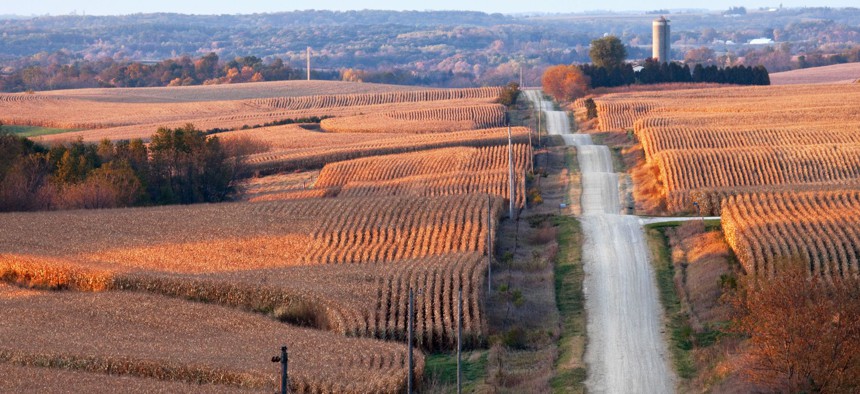Why Trump Needs to Factor Rural Broadband Into His Infrastructure Plans

Toby Talbot / AP Photo

Connecting state and local government leaders
“Otherwise we’re dooming these areas to economic stagnation and worse,” U.S. Sen. Angus King said at a bipartisan Next Century Cities policy event on Wednesday.
WASHINGTON — Local and federal leaders expressed cautious optimism Wednesday about the future of efforts to close the digital divide between rural and urban areas during the forthcoming Trump administration.
Gathered at a Next Century Cities’ Transforming Communities event in the nation’s capital, mayors, U.S. senators and other stakeholders discussed 2017 policy goals for increasing access to high-speed internet nationally.
None were certain Trump will commit to strengthening broadband infrastructure, but most felt his rhetoric to date at least appears promising.
“I don’t think he’s ideological . . . I think he’s sort of pragmatic,” said U.S. Sen. Angus King, an Independent from Maine. “I don’t think people can predict where he’s going to land on any particular issue.”
That Trump will push the Republican agenda of the past few years isn’t a safe assumption, King added. And closing the digital divide isn’t exactly a partisan issue.
The Trump team’s transition website calls for a $550 billion investment in “roads, highways, bridges, tunnels, airports, and railways of tomorrow.” But the internet must be a part of any infrastructure discussions as well, said U.S. Sen. John Boozman, an Arkansas Republican.
Until the 1950s, parts of Arkansas lacked adequate electricity, and now the same is true of broadband. Boozman has received calls from constituents reevaluating major life decisions like homeschooling their children because their home internet is low quality.
While Boozman agreed the incoming administration seems committed to improving infrastructure, he wavered on how much of a priority it would be among competing interests and advised states and localities they “can’t wait for the feds.”
“The answer to these things is not going to come from a piece of legislation,” Boozman said. “It’s going to come from public-private partnerships.”
The city of Winthrop, Minnesota, a small rural community with around 1,400 residents about 75 miles southwest of Minneapolis, has been working with its neighbors to finance and build the RS Fiber Cooperative, a broadband network including 10 cities and 17 townships. Eventually, 6,200 households could be connected.
While Winthrop sits in the middle of “Trump country” and voted three to one in his favor, Mark Erickson, the city’s economic development director, sees expanding high-speed internet access as a nonpartisan issue.
Still, with fiber-to-the-home connectivity as the cooperative’s endgame, federal help with financing is needed. At the very least, loan guarantees would take the risk out of the equation for banks new to broadband, Erickson said.
The city of Ammon, Idaho, a city of around 14,500 residents adjacent to Idaho Falls, pioneered a model where residents own a dedicated fiber line to their home and are free to innovate as they choose with internet service.
“We consider ourselves an infrastructure provider and not an internet provider,” said Mayor Dana Kirkham. “We’re partnering with the end user.”
The challenge that has presented itself is extending fiber to rental properties, which have less incentive to adopt the infrastructure. Children in those homes may struggle to complete after-school assignments that require internet access, dubbed the “homework gap,” and closing that will be harder, Kirkham said.
Broadband was in its infancy when Obama became president, but now states and localities are struggling with how to get it to residents at the right speed for the right price. When places don’t their economies suffer, said the Federal Communications Commission chairman’s counselor Gigi Sohn, who pointed to poor broadband as one factor in General Electric’s decision to move its headquarters in Fairfield, Connecticut, to Boston.
Governments must focus on launching 5G networks and adding intelligence to existing infrastructure, said Blair Levin, a Brookings Institution Metropolitan Policy Program senior fellow, exploring other types of fixed wireless in rural areas where density is an issue. The federal government can assist by improving multiple-dwelling unit (MDU) access and with pole attachments.
Skeptical of Trump’s $550 billion infrastructure investment goal, Levin said he’d like to see all entities be eligible for funding and pay-to-play provisions eliminated—a principle Republicans should be willing to accept. He anticipates a “tsunami of big bang consolidation” where broadband infrastructure is concerned under Trump.
“That’s the opposite of what needs to happen,” Erickson said. “We need things to happen at the granular level.”
Armed with two maps depicting U.S. broadband access and Trump’s recent electoral victory respectively, King illustrated the rural-urban divide in both visuals and made a compelling case for why they’re linked.
“Part of the reason this map looks like this is the widespread … [rural] belief that they’re being left behind, that they’re not being included in the new economy, that they’re missing something, and one of those things is broadband,” King said.
And if high-speed internet doesn’t reach them during Trump’s term?
“[W]e’re dooming these areas to economic stagnation and worse.”
Dave Nyczepir is a News Editor at Government Executive’s Route Fifty and is based in Washington D.C.

NEXT STORY: Can data fuel electric vehicle growth?





